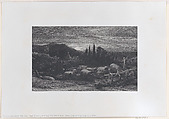The Rising Moon
Samuel Palmer British
Not on view
In 1850, Palmer began to make etchings and would create seventeen plates before his death in 1881. He used the medium to reprise and condense significant themes at the heart of his pastoral vision. "The Rising Moon" was the first of his large etchings and combines elements from the artist's early Shoreham period with others seen in trips to Italy and Devon. The attentive shepherd watching over his flock by moonlight recalls pastoral Sussex, the cypresses echo ones Palmer had sketched at the Villa d'Este, and the rolling hills recall those tramped over during summer tours of Devon. At this stage, between states six and seven, Palmer had nearly completed the image released to the Etching Club for circulation in 1857. The image conveys an intense attachment to subtle light effects, ranging from strong moonlight reflected by clouds to gentler tones used to define woolly sheep, and glimmering outlines that pick out medieval buildings within an enveloping landscape.
Due to rights restrictions, this image cannot be enlarged, viewed at full screen, or downloaded.


